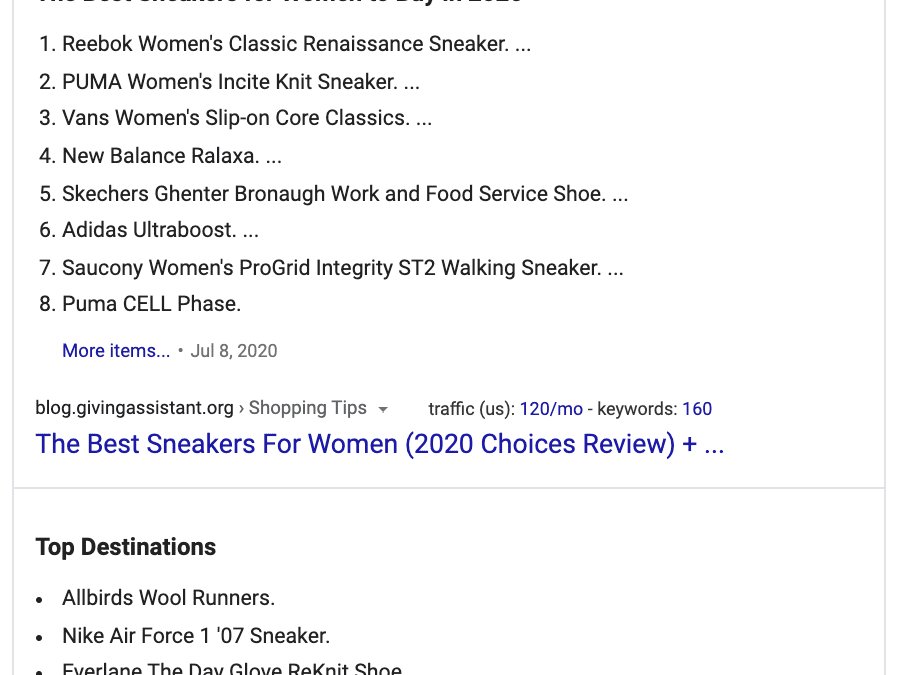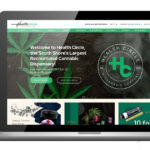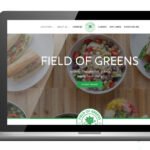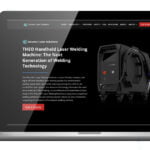Understanding the relationship between search intent, keyword rankings, and organic traffic is essential to understanding the impact of the value that SEO brings to your brand. While many people believe that the number of keyword rankings are an important measure of your success, our digital marketing agency believes that ranking for THE RIGHT keywords is much more valuable than ranking for THE MOST keywords.
For example, if your brand makes athletic shoes, there are a large number of search terms that will be relevant to bringing in traffic at each stage of the funnel. Transactional and commercial keywords like ‘running shoes for sale’ and ‘workout shoes for women’ are great for bringing in search traffic for users that are ready to make a purchase. Informational search queries like ‘streetwear essentials’ that speak to the lifestyle of your customer base can be a great top-of-funnel initiative to introduce new users to the brand. However, keywords like ‘data analytics’ or ‘portable phone charger’ are not relevant to your brand and would ultimately result in users bouncing from your site.
This is where search intent comes into play. We do not just want to rank for a large amount of keywords, we want to rank for the keywords that are relevant to your brand AND match the user’s intent.
What is Search Intent
When it comes to identifying keywords with the correct search intent, it’s important to understand, first and foremost, what search intent is. Search intent (also referred to as user intent or keyword intent) is defined as the purpose or goal of a user’s query in an online search engine. In other words, what are users trying to achieve through their search? Are they looking for general information? Are they trying to figure out how to do something? Are they looking to purchase a product or service? It is important to consider these questions when assessing search intent as understanding the intent behind users’ search is one of the most important factors to consider when building a well-optimized SEO strategy.
Why is Search Intent Important
Search algorithms are constantly recalibrating to deliver the best and most relevant search results. This is exactly why grasping users’ search intent (and optimizing towards said intent) is paramount in conducting a successful SEO strategy. Ultimately, the pages that display at the top of the SERPs are those most relevant to the query. Identifying search intent and properly aligning it with relevant queries will thus dictate the quality of traffic to your site. The more qualified the traffic, the more likely that traffic is to convert.
Why the Wrong Intent Can Hurt Your Site
To fully grasp the importance of search intent, it helps to understand the potential adverse impacts of mismatched search intent. For example, imagine you’re an eCommerce brand selling women’s shoes. You think “best shoes for women” sounds like a perfect query to attract your target audience. You want people to know your shoes are the best! What’s wrong with that? If you type this query into Google, however, you’ll notice the following:
The results for this query have one thing in common: they show options for shoes of various brands and styles and are almost exclusively information-based and not transactional. Although you may like to think your store has the best women’s shoes, Google, unfortunately, probably doesn’t think so. The potential impacts of ranking for a keyword that doesn’t quite have the right intent include:
- Not Ranking in a Competitive Position – We know, you really want to rank for “best shoes for women,” but the likelihood of your store ranking on page one for this keyword is slim to none. You’re better off finding longer-tail keywords suited to the transactional intent of your page such as “comfortable women’s work shoes.”
- Low CTR – If you’re lucky enough to even begin ranking in a competitive position for a keyword with mismatched intent, users may not even click on your search result since your metadata may not speak directly to the intent behind their search (i.e options, variety, information).
- High Bounce Rate – Maybe users do click on your result, but they will likely bounce immediately upon realizing the page does not address their goals (they want options and your shoes are all the same brand).
Now that you understand keyword search intent and why it’s so important, let’s look at how to choose the right keywords for your business.
How to Choose the Right Keyword & Search Intent
Choosing the right keyword can be the difference between traffic and traffic that actually CONVERTS. Usually, there is one extremely high-volume keyword within a given SEO landscape that is “the dream” to rank for on page-1; however, it’s also inherently the most difficult to rank for. Moreover, it might not even be the most conversion-friendly keyword that you should be targeting. So how should we think about choosing the right keywords?
To break it down simply, performing this manual check of the SERP results will help you select keywords that match the users’ search intent:
Determine your page’s intent.
Research and collect your target keyword list.
Manually check your list by viewing the SERP results.
Revise Target Keyword List based on SERP intent.
So let’s perform this check with a hypothetical situation of optimizing a lightweight high-end rain jacket category page for a relatively un-optimized ecommerce client.
- Take a look at the category page, very straightforward… sell jackets.
- Right away we’ve determined to avoid any keywords where the SERP results are a majority of blogs or other resource-type informational pages.
- We are purely looking for keywords that lead to transactional category pages.
- Determine current rankings and see if there are any quick target keyword opportunities to leverage for the page.
- Select initial keywords based on volume, priority, and relevance to the product category page.
- We notice unoptimized general metas. Right off the bat, we would much rather rank for “rain jackets” vs “jackets”
- Research the category page for additional keywords for targeting and notice common words like “weather proof” and “shell” to incorporate into strategy
- The further we go down into detail, something like ”all weather jacket” “rain proof shell jacket”
- Use the list of potential target keywords and perform a manual search of each term. This will help us determine if this category page will even rank for the term.
- If you only see blog posts in the SERP results for a term, move on. Look for other competitor rain jacket category pages and mark down the keywords with correct intent in your list.
- Utilize this groomed list to optimize the category page’s meta data, on-page content, and overall site’s internal linking.
This quick exercise should be applied to all of your priority pages when optimizing or re-optimizing your priority pages to avoid wasting time and effort in the future.
Essentially, delivering a search result that matches the user’s intent increases the likelihood of someone clicking on your SERP listing. But there are occasions where even Google is unsure of the intent. There are times where mixed intent or even shifting intent comes into the SEO equation. With mixed intent, the SERP results will be an array of transactional, product, and informational pages…not one of them dominating the other. Generally, this should not be your main priority keyword…its best left on the backburner until intent starts becoming more consistent. This way you don’t waste your efforts on a keyword that ends up completely switching intent.
Mixed intent can be frustrating but the best way to think of your content is to write “for humans”. Now that Google has implemented BERT, it is “self learning” and therefore attempts to calculate intent. This means, intent will always be reanalyzed regularly and can shift at a given time depending on what users are finding more useful. A good example of this is “Workout Classes” pre and post COVID. Pre-COVID, people were most likely searching for local workout classes…so Google displayed those on page-1. Now that COVID has caused many gym closures, the intent shifted to online workout classes….even though the search keyword itself did not change. Now, this is more of an extreme outlier situation, but the concept holds true… Google will try to match user search intent to the page’s intent…even if the users change their intent over time.
4 Types of Search Intent
Now that we understand how to choose the right keyword and the adaptive sequence of searches that users go through, we are ready to place pen to paper and determine the different types of search intent and their characteristics.
When building keyword research or a ‘keyword map’ for a website, determining the intent of each primary keyword is crucial to the success of rankings and click-thru rates from search engine results pages to your web page.
Determining intent or analyzing search intent could be accomplished in a simple spreadsheet, as seen in the example below:
| Keyword | Search Volume | Intent |
| Best High Temp Oven Mitts | 1000 (monthly) | Commercial |
| Creme Brulee Recipe | 500 (monthly) | Informational |
This type of analysis helps us think carefully about how to serve different kinds of searchers or people based on their individual intentions. The goal of the analysis is to determine how we want to focus our efforts or keywords alongside the most relevant content of the website. In search we know that users are most likely to formulate queries using only a handful words, therefore an SEO company has to determine search intent with precision, plus understand human curiosity for a specific topic or query.
#1 Navigational
Navigational is a specific search query where the intent is likely to be led directly to a specific website. In some cases, the exact URL might not be known and the search engine serves as the “white pages” or directory. Example queries: ‘Alaska Airlines’ or ‘RTIC Cooler 45 Blue’.
Opportunities – This is investigatory traffic. Brands should attempt to dominate ‘brand searches’ so they are not outranked by a competitor. In contrast, this might be an opportunity to steal traffic from a competitor.
High Traffic Value – This search is one that will lead users directly to your website, brand or exact product, as the searcher is already aware of the company. Click-thru rates from search engines is high for the intended brand and low for others.
#2 Informational
Informational intent queries could be a simple check of the weather or a search for ‘who won the Super Bowl in 1981’. Informational queries might not lead to sales or conversions, but it could lead to a share or sign up. Informational search intent keywords should educate or help searchers obtain the informative content they were seeking. This could be blog or article content. With informational queries, users might return to your site later to make a related purchase.
Opportunities – Capture the minds and spark curiosity around your brand. Become an industry ambassador and knowledge leader.
Medium Traffic Value – Searchers might not be ready to purchase, but they could potentially share the information. This is ‘top-of-funnel’ traffic, where users might return to the funnel later with a more targeted search.
#3 Commercial
This is the Zero Moment of Truth (ZMOT), where the searcher or consumer researches a product prior to purchase. The commercial search intent is to help facilitate a decision of the purchase or transaction. Example queries: ‘Best camping coolers’, ‘Reviews of RTIC Coolers’, ‘RTIC Vs Yeti’, and ‘RTIC Cooler Coupons’.
Opportunities – Searchers are in the discovery and awareness stage of the buying cycle. It’s your brand and website’s time to shine.
High Value Traffic – This searcher has zeroed-in on their ‘solution’ or ‘product decision’ and now they are looking into the options available to them.
#4 Transactional
Searcher is seeking where to find or purchase a product, service or local business. This query takes the searcher/prospect /customer into the First Moments of Truth, where the searcher is informed and ready to buy. These queries could include the exact brand and/or product name or they could be generic. Example queries: ‘Ethiopian Restaurant near me’, ‘buy a RTIC cooler’, ‘affordable cooler’, ‘cost of RTIC cooler’, ‘edible CBD for sale online’
Opportunities – The searcher’s mindset is action-oriented, they are ready to purchase or ready to get to a website where there will be the next interaction step – i.e. ‘buy’, ‘download’, or ‘register’.
Very High Value Traffic – When combined with page relevance, top-ranking search results have the best possible chance of conversion.
Writing Blog Content to Match KW Intent
Blog content can be a major driver of new organic traffic visitors to your site. Brands can broaden their organic presence and introduce themselves to new audiences who may not have known they needed the product or service. It is important to note that searchers landing on these pages are top-of-funnel and will be less likely to transact on the first visit. The informational intent behind the search seeks educational content, not commercial content – and Google knows the difference!
As new audiences may not be aware of your offering, it is important to provide education and information on adjacent lifestyle themes. By widening the range of topics that the site addresses, you expand the reach of prospective customers. For example, instead of focusing on a specific product keyword like ‘high tech suitcase’, a luggage brand could write towards “10 Tips for the Modern Digital Traveler” or “How to Keep Your Phone Charged on an Airplane”. Since the prospect might not be aware of your high-tech suitcase that meets all of their travel needs, it is best to provide the education around related information they are seeking.
How to Nurture and Convert Blog Traffic
Conversion comes in many forms – Like, Click, Share, Subscribe, and ultimately BUY! Once you have attracted visitors with educational blog content to match informational search intent, it is now time to move visitors through the funnel without bombarding them with commercial content. Two methods of conversion on blog posts are internal linking and an effective call-to-action:
- Internal Linking – Your blog content should also internally link to relevant Product and Category pages, with the caveat that these visitors will have a lower conversion rate in comparison to commercial intent queries.
- Stylized CTAs Including a branded call-to-action to subscribe to Email is a great way to nurture this top-of-funnel traffic and keep them informed about how your products and services meet their undefined needs.
Optimizing Your Content for Search Intent
Thorough keyword research is the first step in optimizing your website. Rather than just looking for keywords that have decent search volume, matching your pages to the right user intent is going to be the most beneficial for your brand. This can be accomplished by doing a few searches on your own to see what the search landscape looks like. When a keyword displays search results that are similar to your website, you have found the right search intent. If the search results look completely different from your site, then it is not a good keyword to target because the intent is misaligned.
In the end, matching the right search intent is going to bring qualified traffic to your site and put you in front of people who are actively searching for your products or services. Having the right traffic to your site is going to allow you to scale and grow your business organically.
Other Example Images:
The post What is Intent Driven Website Traffic? appeared first on Power Digital Marketing.
Article From: "Power Digital" Read full article
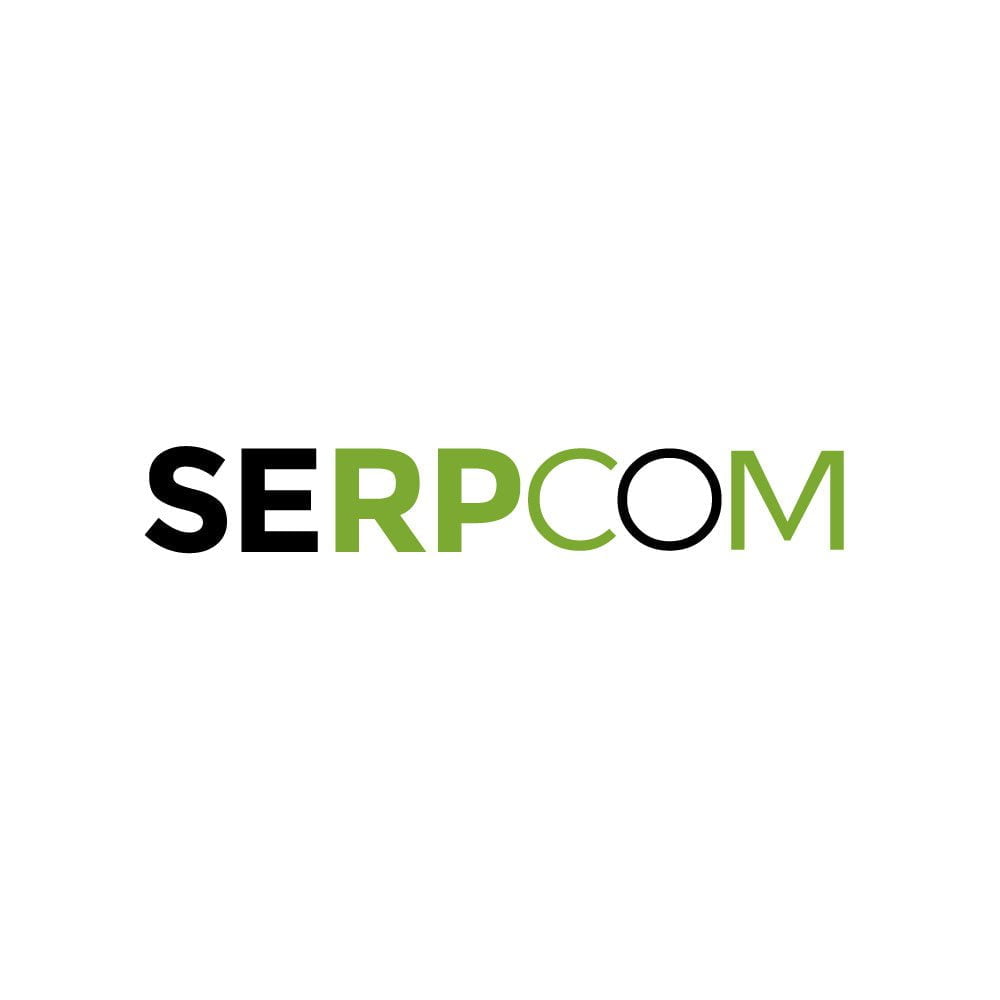 SERPCOM is a full-service Boston digital marketing agency focused on improving online visibility, increasing traffic, raising revenue and providing SEO services.
SERPCOM is a full-service Boston digital marketing agency focused on improving online visibility, increasing traffic, raising revenue and providing SEO services.
SEO-first: A fundamentally better approach to online marketing.
Digital Marketing | SEO | Web Design & Development | Search Engine Marketing

SERPCOM is a full-service Boston digital marketing agency focused on improving online visibility, increasing traffic, raising revenue and providing SEO services. SEO-first: A fundamentally better approach to online marketing.
Digital Marketing | SEO | Web Design & Development | Search Engine Marketing
SERPCOM is a full-service Boston marketing agency focused on improving online visibility, increasing traffic, raising revenue and providing SEO services for leading brands.
Maximize the value of your website and turbo charge your online marketing efforts with SERPCOM. Call or click the button and start making the web work for you.
Just click on the Phone Number to dial on your phone:
